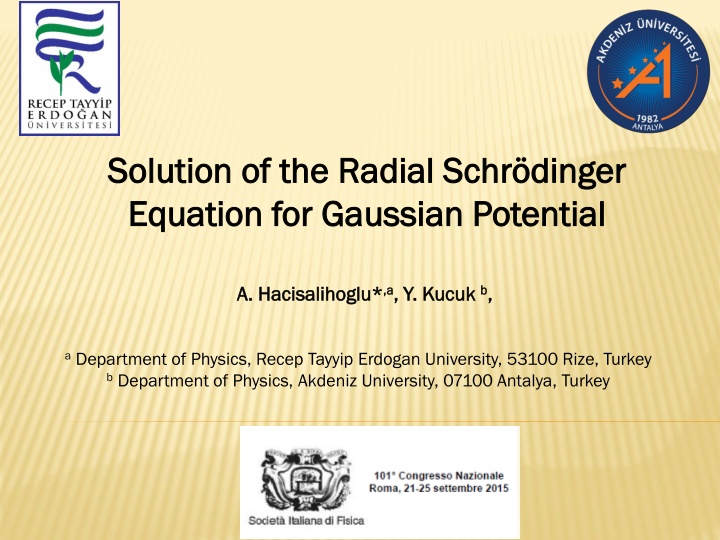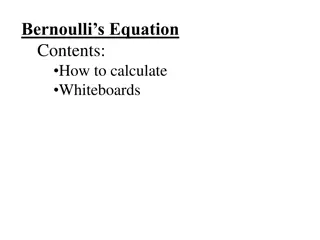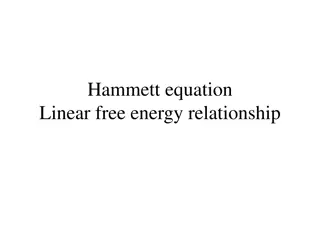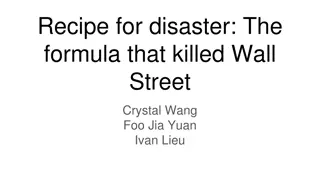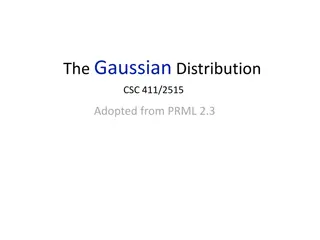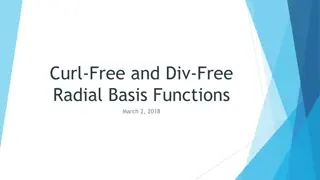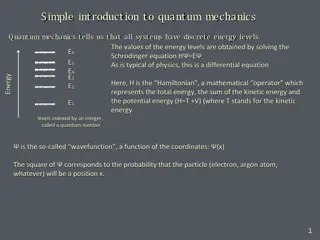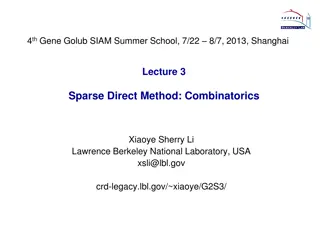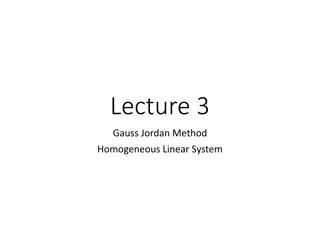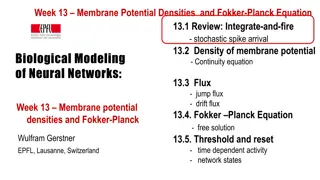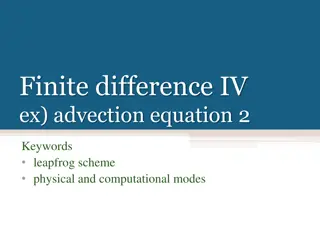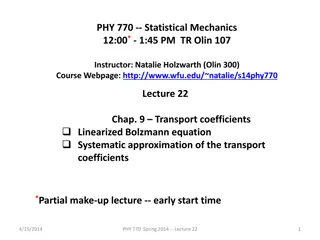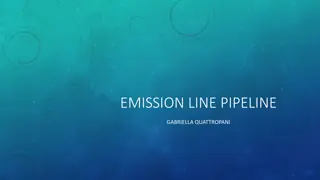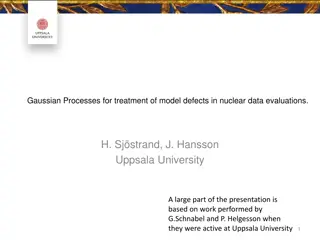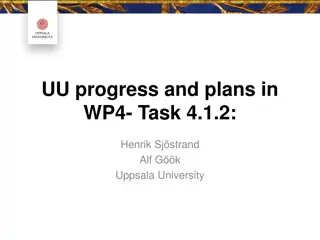Radial Schrödinger Equation Solution for Gaussian Potential
Energy eigenvalues and eigenfunctions in quantum mechanics are studied through the exact solution of the radial Schrödinger equation for Gaussian potentials, using the Asymptotic Iteration Method. The method's efficiency in solving wave equations for different potentials is highlighted, with a focus on nuclear structure and exotic nuclei reactions.
Download Presentation

Please find below an Image/Link to download the presentation.
The content on the website is provided AS IS for your information and personal use only. It may not be sold, licensed, or shared on other websites without obtaining consent from the author.If you encounter any issues during the download, it is possible that the publisher has removed the file from their server.
You are allowed to download the files provided on this website for personal or commercial use, subject to the condition that they are used lawfully. All files are the property of their respective owners.
The content on the website is provided AS IS for your information and personal use only. It may not be sold, licensed, or shared on other websites without obtaining consent from the author.
E N D
Presentation Transcript
Solution of the Radial Schrdinger Solution of the Radial Schr dinger Equation for Gaussian Potential Equation for Gaussian Potential A. A. Hacisalihoglu* Hacisalihoglu*,a ,a, Y. , Y. Kucuk Kucukb b, , aDepartment of Physics, Recep Tayyip Erdogan University, 53100 Rize, Turkey bDepartment of Physics, Akdeniz University, 07100 Antalya, Turkey
CONTENTS I. Introduction II. Asymptotic Iteration Method III. Solution of the Radial Schr dinger Equation for Gaussian Potential IV. Conclusions
I. INTRODUCTION Over the last decades, the energy eigenvalues and corresponding eigenfunctions between interaction systems have raised a great deal of interest in the relativistic as well as in the non-relativistic quantum mechanics. The exact solution of the wave equations (relativistic or non- relativistic) are very important since the wave function contains all the necessary information regarding the quantum system under consideration.The Gaussian extensively used to describe the bound and the continuum states of the interactions systems potential has been
In general,the approximation methods have been used for the solution of the Gaussian potential such as the; Wentzel Kramers Brillouin Approximation [4], Perturbation and Variational Methods [5] , The Higher-Order Perturbation Theory combined with Hypervirial Pade Scheme [6], Large-N Expansion Method [7].
In this study, we apply the asymptotic iteration method (AIM) to solve the radial Schr dinger equation for the Gaussian potentail without any approximation to the potential. It has been shown that this method is very efficient to solve the Schr dinger equation for different potentials. This study, Investigation of the exotic nuclei reactions by using the Continuum Discretized Coupled Channels (CDCC) Model (project number: 110T388) from the scope of the project work was carried out to contribute to the structure of nuclear. At Nuclear structure process, Bohr Hamiltonian defined excitation energy levels of nuclei was aimed to be solved by using the method of asymptotic iteration potential for gauss potential.
II. THE ASYMPTOTIC ITERATION METHOD AIM is proposed to solve the second-order differential equations of the form. = + '' ' ( ) x y ( ) y s x y (2.1) 0 0 0( ) s x 0( ) x where The variables, differentiable. The differential Eq.(2.1) has a general solution. and are sufficiently 0( ) 0 x x ' x x ( ') a x dx ' ( ( '') x 0 = + '' '' ( ) y x 2 ( ) a x dx e c c e + (2.2) 2 1
If k > 0, for sufficiently large k, we obtain the values from ( ) kk s x = ( ) x ( ) ( ) x s x = ( ) x k (2.3) k ( ) kx ( ) ks x Where and = + + ' ( ) x ( ) x ( ) x ( ) x ( ) x s (2.4) (2.5) 1 0 ( ) ( ) ( ) k k k S x S x S x = + 1 1 0 1 k k k k ' k = ( ) x 1,2,3... 1 The energy eigenvalues are obtained from the quantization condition . The quantization condition of the method together with Eq. (2.5) can also be written as follows (2.6) 1 ( ) ( ) ( ) k k k x x S x = + = ( ) x S x ( ) 0 1 k k
the radial Schrdinger equation is converted to the form of Eq. (2.1). Then, and are determined and parameters are calculated. For a given potential such as the Gaussian potential one, 0( ) x 0( ) s x ( ) ( ) and kx ks x condition given by Eq. (2.6). In this equation, k shows the iteration number. The energy eigenvalues are determined by the quantization For the exactly solvable potentials, the energy eigenvalues are obtained from this equation if the problem is exactly solvable and the radial quantum number n is equal to the iteration number k for this case.
specific n radial quantum number, we choose a suitable point, determined generally as the maximum value of the asymptotic wave function or the minimum value of the potential. The approximate energy eigenvalues are obtained from the roots of this equation for sufficiently great values of k with iteration. For nontrivial potentials that have no exact solutions, for a 0 r
III. THE ENERGY EIGENVALUES FOR THE GAUSSIAN POTENTIAL The radial Schr dinger equation is given by (3.1) 2 ( ) 2 d R r dr m + E V = ( ) r ( ) 0 nl R r eff nl 2 2 where m is the mass and Veff(r) is effective potential which is the sum of centrifugal attractive radial Gaussian potentials. + 2 ( 1) l l and the = ( ) r centrifugal V 2 2 mr 2 = ( ) r (3.2) ( ) gauss V r Ae
Veff(r) is effective potential which is the sum of centrifugal and the attractive radial Gaussian potential: + 2 ( 1) l l 2 (3.3) ( ) effective V r Ae = + ( ) r 2 2 mr where A is the depth of the Gaussian potential. Inserting Eq. (2.7) into Eq. (2.6) and using the following ansatzs 2 mE 2 mA A= = n 2 2
We can easily obtain + 2 ( ) ( 1) d R r l l 2 (3.4) 2 Ae dr + + = r ( ) 0 nl R r nl 2 r In order to solve this equation with AIM, we should transform this equation into the form of Eq. (2.1). It is clear that when r goes to zero, and at infinity, therefore we can write the physical wavefunction as follows (3.5) nl nl 2 ( ) exp( ) R r r + 1 l ( ) R r r nl nl 2 + = 1 l r ( ) ( ) r R r r e f
If we insert this wave function into Eq. (3.4), we have the second-order homogeneous linear differential equations in the following form: ( ) ( ) ( 1) 2 2 2 2 r A r dr + 2 4 d f r df r l Ar = + + + + + 2 2 2 (3.6) 6 4 4 ( ) r nl nl Ar r l r f nl 2 4 dr By comparing this equation with Eq. (2.1), we can easily write the and values: (3.7) (3.8) 4 0( ) r 0( ) s r + ( 1) l = + ( ) r 2 2 r 0 r Ar 4 A Ar = + + + 2 2 2 ( ) 2 2 6 4 4 s r r l r 0
( ) ks r 0( ) r 0( ) s r Using and values we calculate and values as follows: 1 ( ) r r ( ) kr 2 = + 4 r (3.9) 4 Ar = A Ar + + ( 3 2 + (3.10) )) 2 2 1( ) s r 2 2( r 4
It is important to point out that if this equation can be solved at every point, then the problem is called as the exactly solvable. r In our potential, since the problem is not exactly solvable, we have to choose a suitable the equation to find 0 ( , ) 0 0 r point and solve values. = kr 0 r In this study, we determine the maximum point of the asymptotic wavefunction, which is the same as the root of , namely, value from the 0( ) r = + 0 1 l = r 0 2
Here, is convergence constant which affects the speed of the convergence [19 21]. We have noticed that the optimum value of is problem dependent. Therefore, we have conducted a series of calculations for and observed that the best convergence is obtained when the constant value, which gives the energy eigenvalues around k = 130 iterations. For other values of and high number of quantum states, the convergence needs more iteration to obtain the energy eigenvalues. from 1 to 40 = 10
ekil ekil- -1: 1: ,m=0.5, A=400, , = 10 and for l=0,1,2,3,4,5,6,7 values changes r- dependent of potential. ( ) eff V r = = 1 1
V. CONCLUSIONS In this study, we have presented the iterative solutions of the radial Schr dinger equation for the attractive radial Gaussian potentials for any n and l quantum states by using the asymptotic iteration method. We have obtained the bound state energy eigenvalues for any n and l states using AIM iteration procedure without any approximation. The obtained results of AIM calculations have been compared the results of other studies. As shown in Table I the very agreement between AIM calculations and other calculations has been obtained.
The advantage of the asymptotic iteration method is that it gives the eigenvalues directly by transforming the second-order differential equation into a form of = + '' ' ( ) ( ) ( ) r f r ( ) ( ) s r f r f r 0 0 n n n analytical solutions if there is and provides the closed-forms for the energy eigenvalues. Where there is no such a solution, The asymptotic iteration method results in exact iterative approach [12, 14, 19 21]. As it is presented, AIM puts no constraint on the potential parameter values involved and it is easy to implement. The results are sufficiently accurate for the practical purposes. It is worth extending this method to examine other interacting systems. The energy eigenvalues are obtained by using an
REFERENCES Aygun, M., Bayrak O. and Boztosun I. 2007. Solution of the radial Schr dinger equation for the potential family v (r) = A/r2 - B/r + Cr2 using the asymptotic iteration method.Journal of Physics B: Atomic, Molecular and Optical Physics 40(3): 537-544. Barakat, T. 2006. The asymptotic iteration method for the eigenenergies of the Schr dinger equation with the potential V(r) -Z/r + gr + r2. Journal of Physics A: Mathematical and General 39(4): 823-831. Bayrak, O. and Boztosun I. 2006. Arbitrary -state solutions of the rotating Morse potential by the asymptotic iteration method. Journal of Physics A: Mathematical and General 39(22): 6955-6963. Bayrak, O. and Boztosun I. 2007. An alternative accurate solution of the exponential cosine screened Coulomb potential. International Journal of Modern Physics C 18(9): 1443-1451. Bayrak, O. and Boztosun I. 2007. Bound state solutions of the Hulth n potential by using the asymptotic iteration method. Physica Scripta 76(1): 92-96. Bessis, N., G. Bessis and Joulakian B. 1982. A note on the Schr dinger equation for the potential A exp(-x 2 )- l(l+1)/x 2. Journal of Physics A: Mathematical and General 15(12): 3679. Buck, B, Friedrich H. and Wheatley C. 1977. "Local potential models for the scattering of complex nuclei." Nuclear Physics A 275(1): 246-268. Ciftci,H., Hall R. L. and Saad N. 2003. Asymptotic iteration method for eigenvalue problems, . Journal of Physics A: Mathematical and General 36 Ciftci, H., Hall R. L. and Saad N. 2005. Construction of exact solutions to the eigenvalue problems by the asymptotic iteration method. Journal of Physics A: Mathematical and General 38(5): 1147-1155 Fishbane P. M., Gasiorowicz S. , Thornton T.2007. Temel Fizik Cilt II. Arkada Yay nlar , Ankara. Griffiths J.( ev: zbek H),1999. Kuantum Mekani ineGiri Nobel Yay nDa t m, Ankara. 1. 2. 3. 4. 5. 6. 7. 8. 9. 10. 11.
Gndz E. 1999. Modern FizieGiri. Ege niversitesi Yaynlar,zmir. Hirschfelder J O 1960 Classical and quantum mechanical hypervirial theorems J.Chem.Phys.33 1462 6 Karao lu B. 1998. Kuantum Mekani ineGiri . G ven Yay nc l k, Ankara Kocak, G., Bayrak O. and Boztosun I. 2007. Arbitrary -state solution of the Hellmann potential. Journal of Theoretical and Computational Chemistry 6(4): 893-903. Krane KS. ( ev: B. arer), 2001. N kleer Fizik 1. ve 2. Cilt. Palme Yay nc l k, Ankara. Lai C S. 1983. On the Schr dinger equation fort he gaussian potential . J. Phys. A: Math. Gen. 16:L181-L185 Li Y., Zhang F and Chen J. 2011. Virial theorem and hypervirial theorem in a spherical geometry. J. Phys. A: Math. Theor. 44: 1-11 12. 13. 14. 15. 16. 17. 18.
Thank you for your attendance Thank you for your attendance September 2015 September 2015- -Rize, TURKEY Rize, TURKEY
